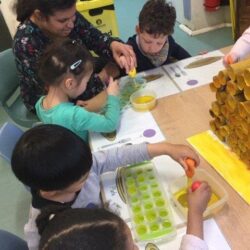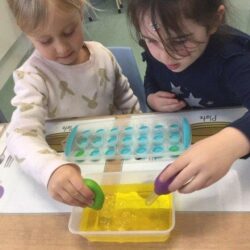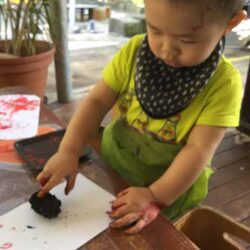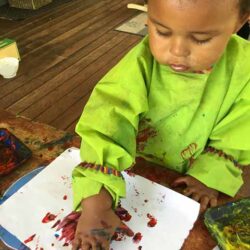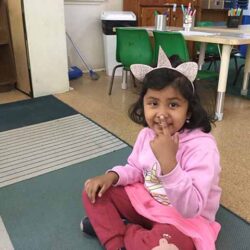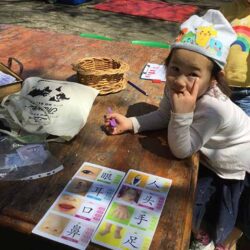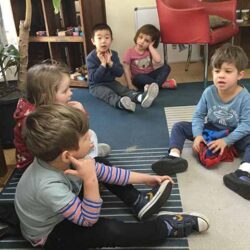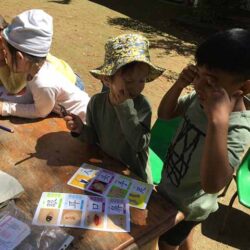Johnson House
The children in Johnson House have continued to show great interest in a ‘bees’ project facilitated by early childhood educator Madhu. The children have been discussing how bees gather nectar from flowers, and they have been using eye droppers and coloured water to explore and act out the process of gathering nectar. Many visual images and lots of information has been shared, aimed at helping to extend the children’s knowledge of bees and the processes they use to make honey.
As part of this project, the children were excited to have an opportunity to taste natural honeycomb. Before tasting it, the children were invited to use their five senses to explore the honeycomb. They were asked questions such as “What does it smell like? and “What does it feel like?”. The children’s responses included “A bit sticky to touch” and “It smells really sweet”. This experience provided the children with the chance to have a hands-on learning experience and to extend on their knowledge. Continuity of learning through projects is an important aspect of the program as it helps children to revisit previous learnings, broaden their knowledge and provides an opportunity for in depth learning and exploration to take place.
Murray House
Infants
The children in Murray House infants love playing with natural materials, and educator Alisa has been extending this interest by providing them with a range of Australian native plant items collected from outside Murray House.
Alisa collected dried sweet gum balls to facilitate the development of children’s ‘functional play’. This is an important stage of play and is often described as the ‘first play’ of children. Any repetitive action that a child finds enjoyable is considered functional play, and it allows them to practise their fine motor, language and cognitive skills. The children repeatedly filled up milk containers with the sweet gumballs and then tipped them out, demonstrating engagement in functional play. The children loved the spiky and rough texture of the gum balls.
Alisa also collected a basket of bottle brush flowers for the children, and they were curious about their texture as they examined the flowers by touching their spikes, as well as smelling the flowers and leaves, and swishing and shaking the leaves.
To extend this interest further, this week the children were given the opportunity to use natural materials as tools in creative art experiences, allowing them to explore and discover the variety of textures and patterns that could be produced with these natural tools.
Australian native plants have been a great addition to the Murray House infants’ program as the children have been able to make use of these in a variety of play experiences. This has also created opportunities for the children to connect with the natural environment and to explore native plants.
Toddlers
Schemas in children’s play and caring for the learning environment
The children in Murray House toddlers are always very busy exploring transportation ‘schema play’ by transporting dirt and sand from one area to the other with their trucks, bowls, pots and pans etc. ‘Schemas’ are patterns of repeated behaviour that allow young children to explore and develop their play through their thoughts and ideas. This form of play is very rewarding for children as they gain a lot of satisfaction from completing a task and seeing something happen as a result of their hard work.
As a result of the children’s play, the soft fall grounds have become very slippery and dusty from sand and mud. Educator Denise has been routinely encouraging the children to assist her to sweep the soft fall and talking with them about taking care of the environment.
Sweeping has assisted the children to increase their knowledge of caring for and respecting their learning environment. The development of their social skills has also been enhanced as they have needed to share and take turns with the limited number of brooms available. Sweeping also encouraged the children to build their spatial awareness, as well as their gross motor skills in body movement and position, especially ‘crossing the midline’. Crossing the midline is when we move our arm or leg across the middle of our body to perform a task. This is vital to the development of using both sides of the body together. It also promotes the coordination and communication of the left and right hemispheres of the brain and encourages bilateral coordination, the process of developing a dominant hand and development of fine motor skills.
Promoting Aboriginal perspectives
The children in Murray House toddlers are also continuing to enjoy listening to their favourite story books. Capitalising on their interest in story books, educators have been intentionally incorporating Aboriginal perspectives into the program through reading groups. The educators have been speaking to the children about how Aboriginal People are the traditional custodians of the Wangal Land on which they live and play. Children and educators regularly sing their Wangal song prior to reading the stories:
We live on Wangal land
We play on Wangal land
Every day we come together and learn on Wangal land
Thank you Wangal land, thank you Wangal land
Thank you Wangal people for sharing your land.
Promoting STEM (science, technology, engineering, and mathematics) learning
Educators are also continuing to extend children’s interests and learning through STEM experiences and intentional teaching, for example, through counting books, and engaging in size and shape sorting experiences. The children have also been exploring speed and movement with balls and various other objects. As educators have observed the children’s play intentions, they have facilitated play experiences for them by providing appropriate learning resources, encouraging their reflective thinking and problem-solving skills, and scaffolding their learning.
Robinson House
Since the beginning of the year the children in Robinson House have shown an interest in diverse languages, and some have shared their knowledge of their home languages with peers and educators.
In recent weeks Robinson House children have continued their Mandarin-learning journey with educator Emily through songs and games. They have also begun learning a few words from the Gadigal language via the ABC radio program Word Up, which explores the diverse languages of Australia’s First Peoples. Every day the children and educators in Robinson House acknowledge that they are on Gadigal and Wangal land, so it is exciting for them to learn some words that come from this Country!
Earlier in the year the children learnt a welcome song in Noongar language from Western Australia, and they have also recently learnt some Key Word Signs (hand signs) with The Infants’ Home’s Speech Pathologist Kacey. The children are not only learning about the diversity of languages across the world, but also within Australia. Now when they sing Twinkle Twinkle Little Star, the children ask to sing it in English, Mandarin, and Arabic!
